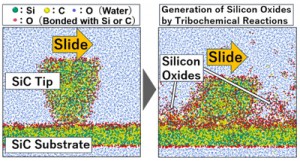[Published online Journal of Computer Chemistry, Japan Vol.19, 139-141, by J-STAGE]
<Title:> Reactive Molecular Dynamics Simulation on Friction-induced Chemical Reactions of SiC in Water Environments
<Author(s):> Masayuki KAWAURA, Yang WANG, Yusuke OOTANI, Nobuki OZAWA, Momoji KUBO
<Corresponding author E-Mill:> momoji(at)imr.tohoku.ac.jp
<Abstract:> Silicon carbide (SiC) exhibits super low friction in water environments. It has been well noticed that this super low friction property is caused by the generated lubricating layers through friction-induced chemical reactions. However, the chemical reactions at the friction interface have not been well clarified because it is difficult to observe the tribological processes at the friction interface in experiments. In the present study, we simulated the friction processes of SiC/SiC in water environments using reactive molecular dynamics simulations. It is interesting to observe that the hydrolysis reactions of Si-C and Si-Si bonds occurred, and however, the chemical reactions of C-C bonds hardly occur, indicating that Si atoms are preferentially oxidized and C atoms are not. The oxidation of Si atoms in SiC generates colloidal silica lubricating layers at the friction interface, being responsible for the super low friction of SiC.
<Keywords:> Molecular Dynamics, Friction, Wear, Silicon Carbide, Water Lubrication
<URL:> https://www.jstage.jst.go.jp/article/jccj/19/4/19_2021-0010/_article/-char/ja/
<Title:> Reactive Molecular Dynamics Simulation on Friction-induced Chemical Reactions of SiC in Water Environments
<Author(s):> Masayuki KAWAURA, Yang WANG, Yusuke OOTANI, Nobuki OZAWA, Momoji KUBO
<Corresponding author E-Mill:> momoji(at)imr.tohoku.ac.jp
<Abstract:> Silicon carbide (SiC) exhibits super low friction in water environments. It has been well noticed that this super low friction property is caused by the generated lubricating layers through friction-induced chemical reactions. However, the chemical reactions at the friction interface have not been well clarified because it is difficult to observe the tribological processes at the friction interface in experiments. In the present study, we simulated the friction processes of SiC/SiC in water environments using reactive molecular dynamics simulations. It is interesting to observe that the hydrolysis reactions of Si-C and Si-Si bonds occurred, and however, the chemical reactions of C-C bonds hardly occur, indicating that Si atoms are preferentially oxidized and C atoms are not. The oxidation of Si atoms in SiC generates colloidal silica lubricating layers at the friction interface, being responsible for the super low friction of SiC.
<Keywords:> Molecular Dynamics, Friction, Wear, Silicon Carbide, Water Lubrication
<URL:> https://www.jstage.jst.go.jp/article/jccj/19/4/19_2021-0010/_article/-char/ja/
